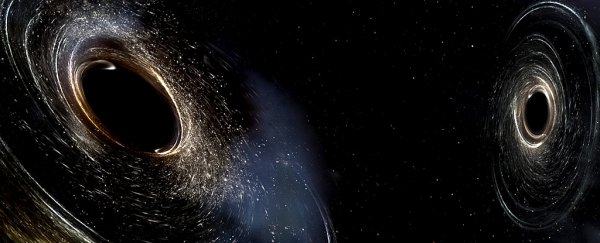Black holes could be making cataclysmic collisions across the Universe every few minutes. Unfortunately, the aftermath is too faint to alert our current detection technology.
But a clever new technique could allow us to "hear" these collisions by finding their signals in the background static that LIGO-Virgo's detectors are picking up all the time.
Even though we humans can't hear any sounds coming from space, the gravitational wave signal of two black holes or neutron stars colliding can be translated into a sound wave.
This has been done for the six confirmed gravitational wave signals picked up since that first groundbreaking detection in 2015.
But these events are much more frequent than we have detected to date, according to Eric Thrane and Rory Smith of the ARC Centre of Excellence for Gravitational Wave Discovery (OzGrav) and Monash University.
Both of these researchers participated in that first discovery, as well as last year's jaw-dropping neutron star collision.
When two black holes or neutron stars collide, the event is so massive and disruptive that it sends gravitational waves rippling out across the fabric of space-time.
Although predicted by Einstein's theory of general relativity in 1915, it wasn't until 100 years later that we were able to develop instrumentation sensitive enough to detect these ripples.
The technology is still in its infancy and is being refined over time. This means, potentially, that there is a lot we still can't detect.
Every year, the researchers say, there are over 100,000 gravitational wave events that are too faint for the interferometers of the LIGO-Virgo collaboration to detect unambiguously.
These are caused by smaller black hole collisions, and collisions much farther away. Rather than showing up as individual signal spikes, their signals resolve into a sort of "hum".
Researchers have been trying to find this hum for years - and now Thrane, Smith and their team believe they may have developed a method sensitive enough to detect it among the gravitational wave background static picked up by the interferometers.
"Measuring the gravitational-wave background will allow us to study populations of black holes at vast distances," Thrane said.
"Someday, the technique may enable us to see gravitational waves from the Big Bang, hidden behind gravitational waves from black holes and neutron stars."
The team has developed an algorithm that can comb through the LIGO-Virgo static data and pick out the signals of the black hole collisions - when converted to audio, it's an upsweep of sound that ends in a sort of loud "BLOOP."
"It's the same thing your brain does when your car radio goes out of reception and goes to static," Smith told the Sydney Morning Herald.
"Little bits and pieces of radio stations still come through - but your brain is able to put them together and work out what song is playing."
To test it, they created simulations of black hole collisions, then had their algorithm try to pick them out of background static.
They found that it wasn't fooled by artefacts such as background glitches, and was reliably able to pick out unpredictable signals.
It has yet to be applied to real data, but the researchers are confident it will work, especially run on a powerful new supercomputer at Swinburne University.
OzSTAR, with a peak performance of 1.2 petaflops, will be used to sort through the vast amounts of data being generated by gravitational wave detectors, looking for black hole and neutron star mergers in real-time.
"It gives us a taste of the universe at its most extreme," Matthew Bailes, director of OzGrav, told the ABC.
"It's when you've sort of set the laws of physics to 'stun', and to a physicist that is an exciting place to probe."
The team's research has been accepted into the journal Physical Review X, and can be read in full on arXiv.
